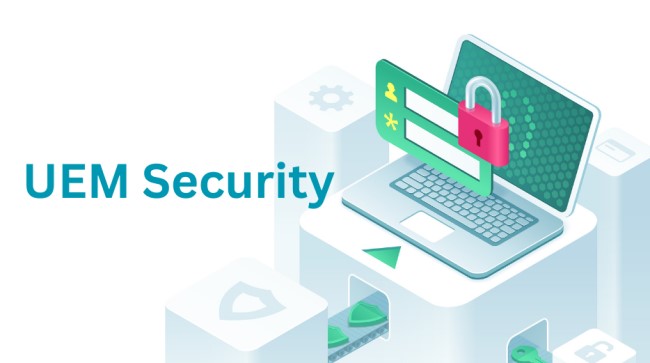UEM Secuity Overview: What's it & How to Enhance
UEM stands for Unified Endpoint Management. It is a more modern and comprehensive security solution built on technologies like MDM and EMM. As cyber threats become more severe, computer network breaches can spell disaster.
Moreover, with the advancement of technology, threats have also evolved. As a result, previous solutions like mobile device management (MDM) are no longer viable. UEM security allows security admins to configure, monitor, and enforce security rules from a single console.
It mitigates errors and misconfigurations. As a result, your network is more secure and ready to tackle even the latest threats. Here is all you need to know.
- Part 1 : Facts on Device Insecurity and Growth of Workplace Usage
- Part 2 : What Is UEM Security?
- Part 3 : UEM Features to Enhance Security
- Part 4 : How Does UEM Work to Enhance Endpoint Security?
- Part 5 : Tips to Make the Best Use of UEM Security Features
- Part 6 : What Are the Potential Security Threats in UEM?
- Part 7 : FAQs
Part 1: Facts on Device Insecurity and Growth of Workplace Usage
Our workplace is constantly evolving. Employees now work on multiple devices. Moreover, many of them are starting to prefer remote work. As a result, the pressure of a comprehensive security system is now more important than ever.
Without proper security, your corporation is vulnerable to attacks. Additionally, it does not take much for a skilled hacker to access your network. And once they are in, they can cause massive amounts of damage.
Therefore, UEM in cyber security, also called Unified Endpoint Management, is so important. UEM helps to enhance your security and also for data governance and e-governance as well. It allows businesses and governments to manage and monitor all devices from a single console securely.
As a result, your IT team's work is more streamlined and less error-prone. When you make the job of the security admin easier, they can focus on the things that matter – keeping your network secure.

Part 2: What is UEM Security?
Unified Endpoint Management (UEM) lets you manage security across your network. It can protect all end-user devices like laptops, phones, tablets, and desktops.
Moreover, managing all these devices is easier with UEM. You can manage many user devices right from a single console. It simplifies the process and reduces the chances of human errors. Therefore, misconfigurations are no longer an issue.
Apart from the ease of a single console, it also works on all operating systems like Microsoft Windows, Macintosh, iOS, Android, Google ChromeOS, and Linux.
UEM is a relatively new technology. But it uses some aspects of traditional security solutions like MDM. Traditionally, organizations relied on Mobile Device Management to secure their networks.
However, due to the sheer number of devices and cross-border teams, MDM is no longer the most secure solution. UEM inherits all the benefits of tried and tested security measures and improves upon them.
Part 3: UEM Features to Enhance Security
Unified Endpoint Security tools come equipped with various advanced security features. All the tools together give you a complete security solution.
Security-related Features for Devices
Configuring computers and devices with UEM gives you device-level control like data encryption, remote access, and more.
- Data Encryption: Data encryption adds an extra layer of protection. It keeps sensitive data on work devices safe.
- Remotely control, lock, or wipe: It gives you complete control over devices that are not on-premise. You can lock or even wipe the data if needed.
- Enforce password policies: If your organization has specific password policies, UEM software can help you to enforce them seamlessly.
- Manage jailbroken or rooted devices: With UEM tools, you can manage devices that can be a potential security threat, like jailbroken devices.
- Block external devices such as USB: Thanks to UEM, you can block devices on your network from accepting USB and other external devices.

Security-related Features for Applications
Application-level features make BYOD easy to implement and secure. Here are some application-related features of UEM:
- Application Management: Proper app management for granular control and better monitoring.
- Patch Automated Updating: Automated updating becomes easier and seamless from a single console.
- Containerization for BYOD Separates corporate data from personal data on a device so employees can use their devices without any invulnerability.
- Threat Detection: Ability to detect threats before they become major problems. As a result, you can take action faster.
Security-related Features for Network
Networks are often the primary point of attack. Therefore, securing the network will enhance the security of any organization:
- VPN Configuration: UEM allows you to configure VPNs seamlessly. It allows you to disguise your identity and increase security.
- Network Access Control: It allows you to monitor and regulate device access to your corporate network.
Security-related Features for User Access
Monitoring and controlling user access can keep bad actors from getting into the system even if they gain access to sensitive information.
- Multi-factor Authentication: Features like multi-factor authentication are crucial to protect devices and sensitive information like passwords. It ensures that even if someone can access your device or password, they cannot immediately log in.

Part 4: How Does UEM Work to Enhance Endpoint Security?
Having multiple endpoints simply increases the risks of a potential breach. This is one of the biggest security problems Unified Endpoint Security solves. With Unified Endpoint Monitoring, you can manage and monitor all devices from one place.
1) Enrolling Devices to the Admin Console: The streamlined UEM process makes it much easier for users to enroll their devices into the admin console. It can provision new devices easily too. Additionally, UEM tools can also help enforce security policies.
2) Up-to-date Endpoint Security: UEM allows you to keep your antivirus definitions up-to-date to prevent you from the latest threats.
3) Configure Device and Application Settings: UEM tools allow your IT team to manage app use. As a result, you can manage which apps users are allowed to install.
4) Protect Corporate Data: UEM enhances your network security by ensuring your corporate data stays protected. Tools like blocking external USB devices, VPNs, and network access control (NACs) allow you to meticulously manage devices, enhancing security.
5) Control User Access: UEM software lets your IT team define specific user access. For example, you might not want third parties to access proprietary or classified data.
6) Monitoring: Ease of monitoring and status checks helps your network security see what devices are connected. If anything suspicious happens, you can then take prompt action.

Part 5: Tips to Make the Best Use of UEM Security Features
Hackers use a variety of common tactics to compromise networks. They might use social engineering, phishing, DDoS attacks, and more. Therefore, educating users and admins on tackling these common attacks is essential.
Handling Phishing Attacks
Email phishing attacks are one of the most common threats organizations must deal with. UEM's secure endpoint management, encryption, NACs, and web filtering blocking access to malicious websites help users stay safe.
Handling Ransomware and Virus Attacks
User device monitoring and app management protect you from ransomware. It also deletes any ransomware present in devices. Moreover, UEM software can use AI-powered analytics to recognize patterns to protect against future attacks.
Handling Data Breaches
UEM tools make it easier to enforce password policies. It can also block unrecognized devices and users. Therefore, the chances of data breaches are significantly reduced.
Handling DDoS Attacks
DDoS attacks can cripple even the most robust network. However, UEM security tools make it easy for your team to configure networks and devices without vulnerabilities.
Part 6: What Are the Potential Security Threats in UEM?
UEM cybersecurity software provides a robust and comprehensive solution for all organizations. However, it is not immune to all kinds of threats and issues. For example, UEM cannot provide protections against these threats:
- Device Loss or Theft: UEM cannot protect you against misplaced devices. Or even theft, for that matter. Training employees on how to handle devices is the best way to mitigate the risk.
- Viruses: UEM cannot provide ample protection against all viruses. Therefore, educating users on safe device usage is important.
- Insider Threats – Disgruntled employees: Organizations need to have rules in place to deal with insider threats. UEM tools do not mitigate the risks of rogue employees since they already have network access.






Leave a Reply.